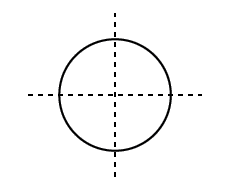
Identify how many lines of symmetry drawn are there in the given 2D figure?


Answer
493.8k+ views
Hint: In a Circle, A line (drawn at any angle) that goes through its center is a Line of Symmetry. So a Circle has infinite Lines of Symmetry. It is not necessary that all the figures possess a line or lines of symmetry in different figures. Figures may have no line of symmetry sometimes or they may have \[1,{\text{ }}2,{\text{ }}3,{\text{ }}4{\text{ }} \ldots \infty \] number of lines of symmetry as a circle is having Infinite lines of symmetry.
Complete step by step solution: The line drawn through the center of a figure that divides it into two equally divided figures is known as the Line of Symmetry. The figure is symmetric along all the diameters. Since, there can be an infinite number of lines drawn through the center. This makes a lot of sense if you think about it. Any diameter must go through the center and two points on the circle; making it cut the circle's circumference into two equal parts. Therefore, there are two lines of symmetry in the circle.
Note: There are two lines drawn in the figure. Therefore, there are two lines of symmetry in the circle. Each regular polygon (equilateral triangle, square, rhombus, regular pentagon, regular hexagon etc.) are symmetry. The number of lines of symmetry in a regular polygon is equal to the number of sides a regular polygon has. Some figures like scalene triangle and parallelogram have no lines of symmetry.
Complete step by step solution: The line drawn through the center of a figure that divides it into two equally divided figures is known as the Line of Symmetry. The figure is symmetric along all the diameters. Since, there can be an infinite number of lines drawn through the center. This makes a lot of sense if you think about it. Any diameter must go through the center and two points on the circle; making it cut the circle's circumference into two equal parts. Therefore, there are two lines of symmetry in the circle.
Note: There are two lines drawn in the figure. Therefore, there are two lines of symmetry in the circle. Each regular polygon (equilateral triangle, square, rhombus, regular pentagon, regular hexagon etc.) are symmetry. The number of lines of symmetry in a regular polygon is equal to the number of sides a regular polygon has. Some figures like scalene triangle and parallelogram have no lines of symmetry.
Recently Updated Pages
The correct geometry and hybridization for XeF4 are class 11 chemistry CBSE

Water softening by Clarks process uses ACalcium bicarbonate class 11 chemistry CBSE

With reference to graphite and diamond which of the class 11 chemistry CBSE

A certain household has consumed 250 units of energy class 11 physics CBSE

The lightest metal known is A beryllium B lithium C class 11 chemistry CBSE

What is the formula mass of the iodine molecule class 11 chemistry CBSE

Trending doubts
When Sambhaji Maharaj died a 11 February 1689 b 11 class 8 social science CBSE

Who is the author of Kadambari AKalidas B Panini C class 8 social science CBSE

Advantages and disadvantages of science

Write the smallest number divisible by both 306 and class 8 maths CBSE

In Indian rupees 1 trillion is equal to how many c class 8 maths CBSE

What led to the incident of Bloody Sunday in Russia class 8 social science CBSE




